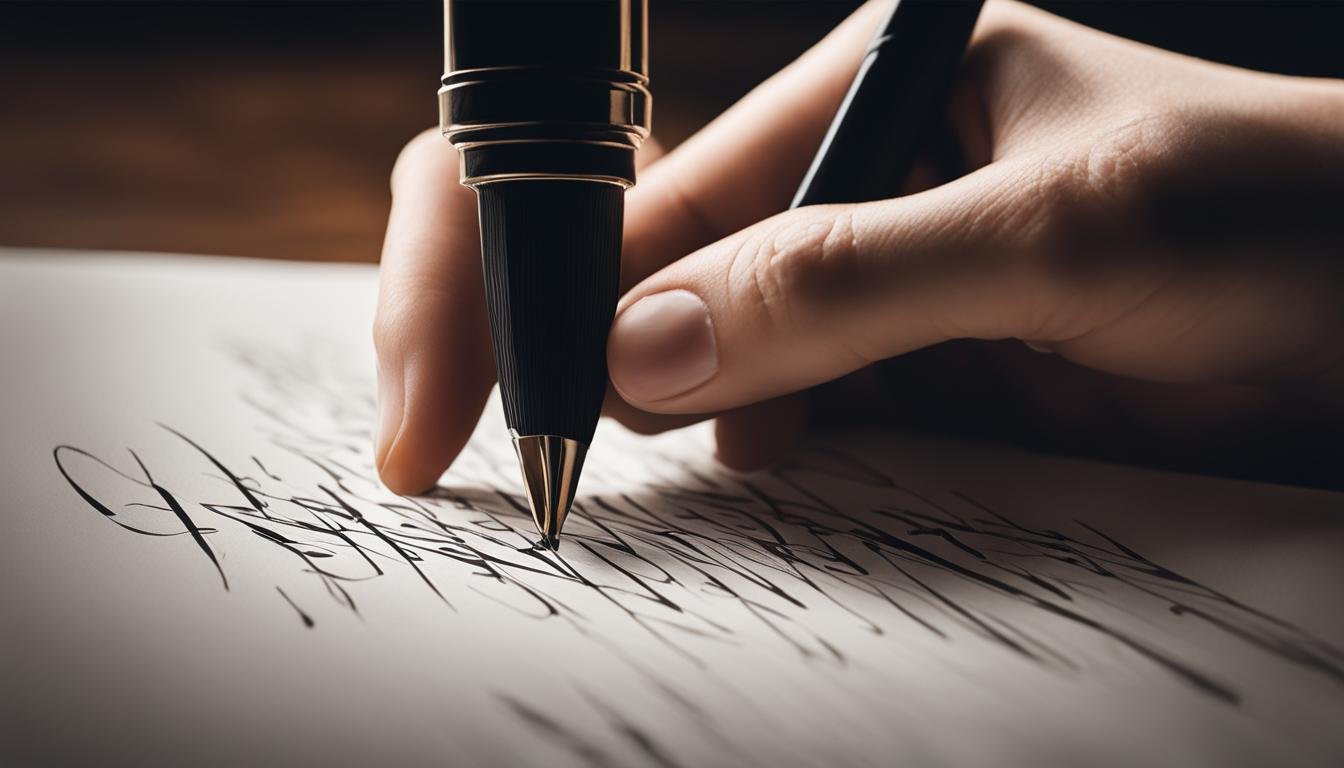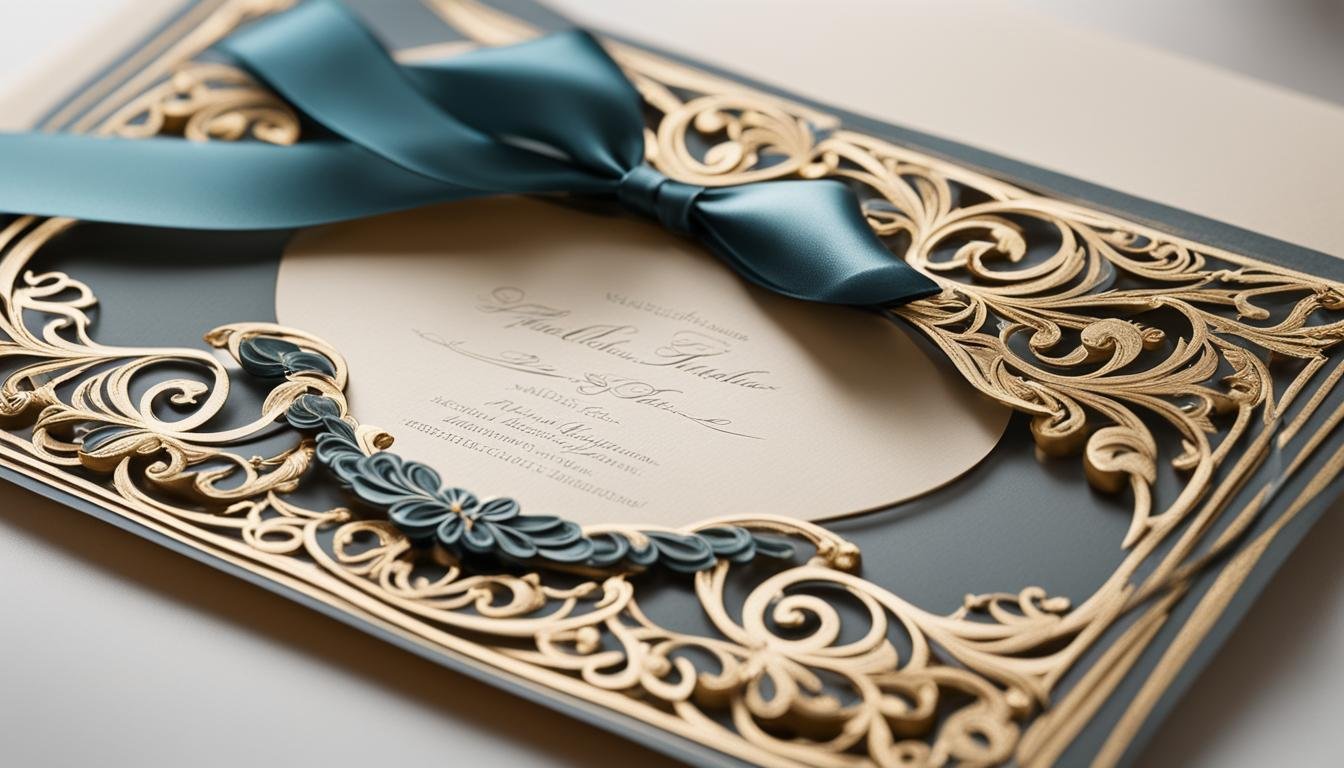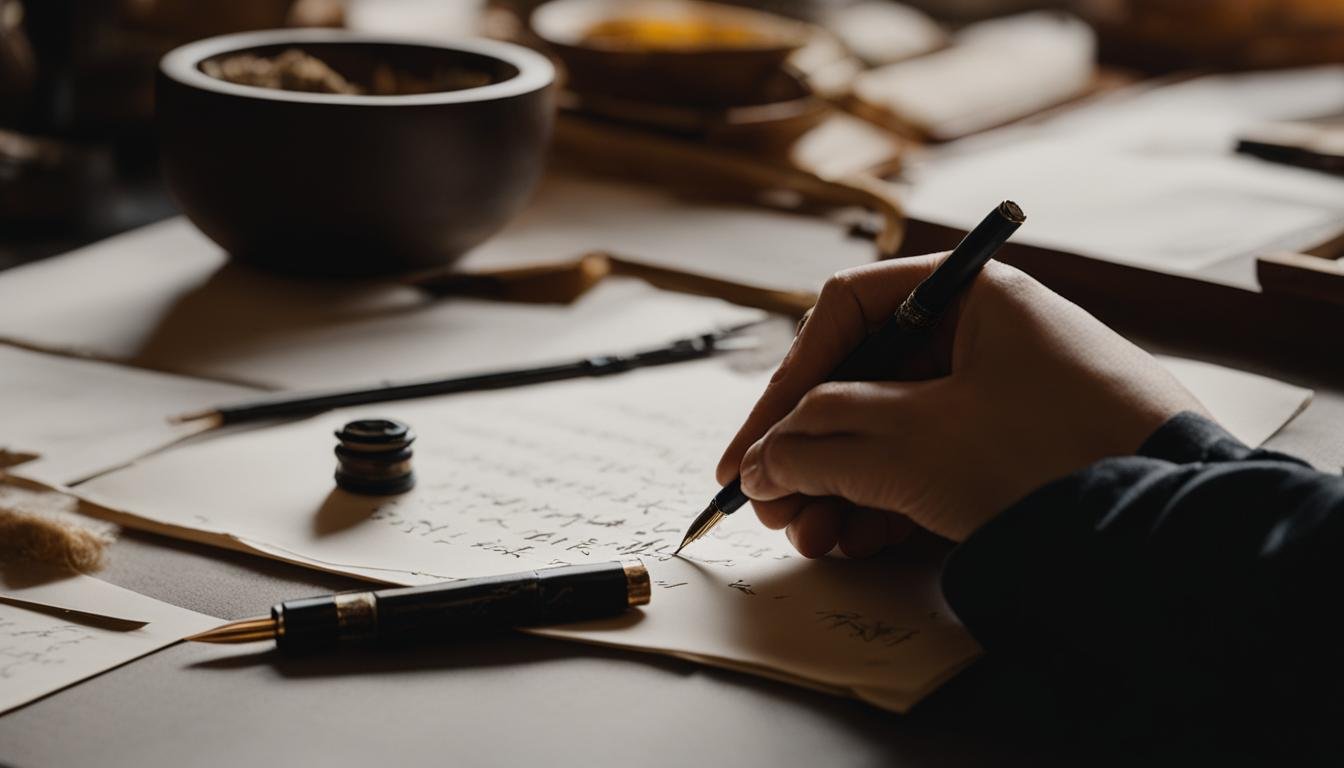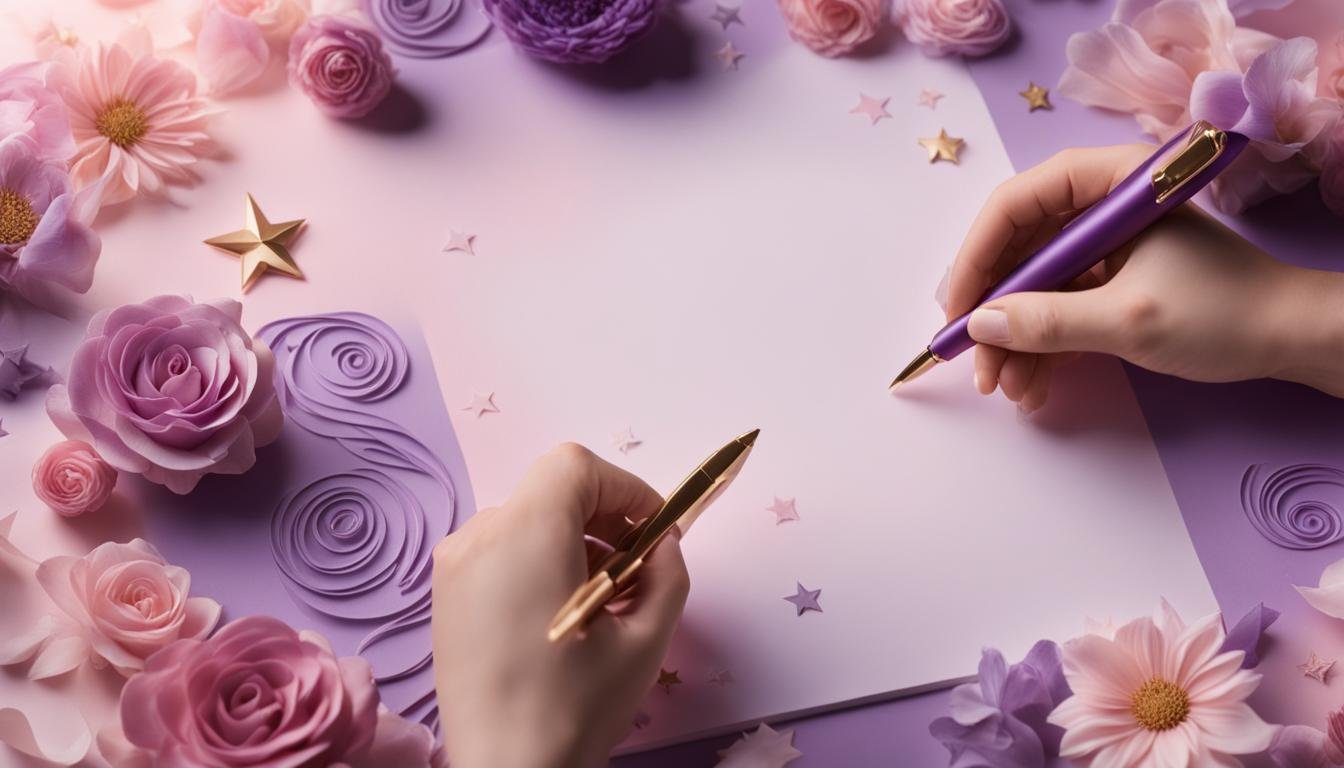Calligraphy Guideline Basics: Master Line Perfection Instantly
Welcome to our comprehensive guide on calligraphy guideline basics. In this section, we will explore the fundamental concepts you need to know to achieve line perfection in calligraphy. Understanding calligraphy guidelines is essential for creating beautiful letterforms and developing your skills as a calligraphy artist.
Before we dive into the details, let’s take a moment to appreciate the artistry of calligraphy. Calligraphy is a timeless form of writing that combines artistic expression with precise lettering. It has been practiced for centuries and is celebrated for its elegance and beauty.
Now, let’s get started with the basics. Calligraphy guidelines provide the structure and framework for your letterforms. They act as a guide to help you maintain consistent letter heights, spacing, and proportions. By following these guidelines, you can achieve the desired line perfection that is characteristic of beautiful calligraphy.
Throughout this guide, we will cover everything from understanding basic calligraphy strokes and practicing like a pro to choosing the right tools and overcoming common challenges. Whether you’re a beginner or looking to enhance your existing skills, this guide will provide you with the knowledge and resources to succeed in the art of calligraphy.
Key Takeaways:
- Calligraphy guidelines are essential for achieving line perfection.
- Understanding basic calligraphy strokes is crucial for creating cohesive letterforms.
- Practicing calligraphy with the right tools and techniques is the key to improving your skills.
- Differentiating between modern calligraphy and hand lettering allows for personal expression.
- Overcoming common calligraphy challenges requires consistency and creativity.
Understanding Basic Calligraphy Strokes
Mastering basic calligraphy strokes is essential for beginners to develop their skills and create beautiful letterforms. These strokes serve as the building blocks for lowercase letters in calligraphy and form the foundation of the art. By understanding and practicing these strokes, you can achieve consistency and precision in your work.
There are four main basic calligraphy strokes that you need to familiarize yourself with:
- Downstroke: This is a vertical stroke that is thick and bold. It is created by applying pressure when moving the pen downwards.
- Upstroke: This is a thin and light stroke that is created by moving the pen upwards without applying pressure.
- Underturn: This stroke is curved and transitions smoothly from a thin to a thick line. It is commonly used in letters like “a”, “d”, and “g”.
- Overturn: This stroke is also curved but transitions from a thick to a thin line. It is commonly used in letters like “b”, “p”, and “o”.
By practicing these strokes individually and combining them in different ways, you can create a wide variety of letterforms and develop your own unique calligraphy style. Remember to start with light pressure and gradually increase it to achieve the desired thickness in your downstrokes. Consistency and practice are key to mastering basic calligraphy strokes and improving your overall technique.
| Stroke Type | Examples |
|---|---|
| Downstroke | h, k, t |
| Upstroke | i, j, l |
| Underturn | a, d, g |
| Overturn | b, p, o |
Practice these basic calligraphy strokes regularly, focusing on achieving consistency and control. Experiment with different pressures and angles to create unique variations in your letterforms. By mastering these strokes, you will build a strong foundation for further exploration and experimentation in the world of calligraphy.
Practicing Calligraphy Like a Pro
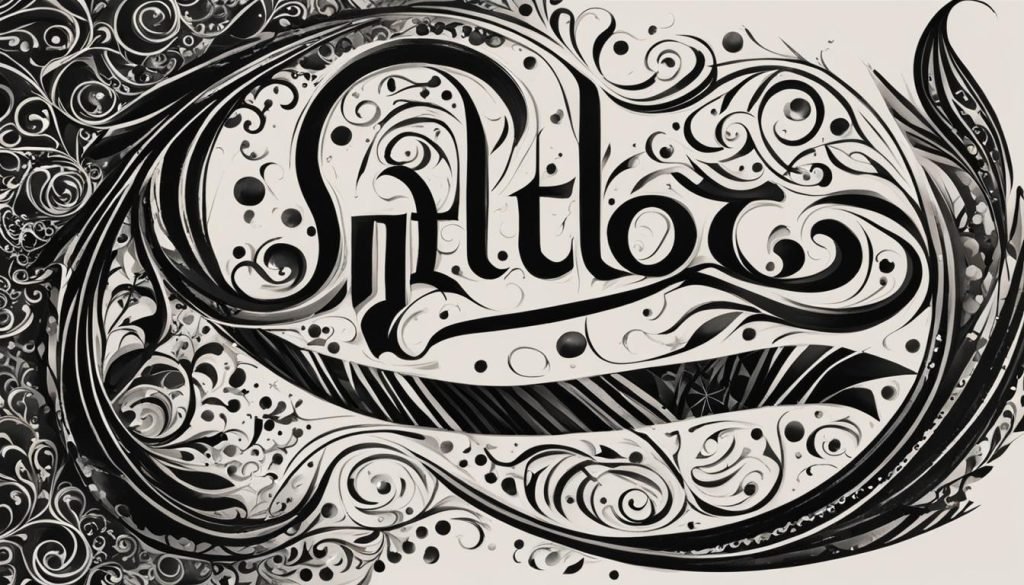
Are you ready to dive into the world of calligraphy? Starting a new artistic journey can be both exciting and intimidating, but with the right tips and techniques, you can practice calligraphy like a pro. In this section, we will guide you through the steps to get started and provide valuable insights to improve your calligraphy skills.
Understanding the Difference: Calligraphy vs. Cursive Writing
Before we delve into the techniques, let’s clarify the difference between calligraphy and cursive writing. While cursive writing aims for speed and legibility, calligraphy is an art form that focuses on creating beautiful and expressive letterforms. In calligraphy, each stroke is intentional and deliberate, making it crucial to practice each stroke individually to achieve precision and consistency.
To start your calligraphy journey, you will need some essential tools and materials. The most common tools include calligraphy pens, brush pens, ink, and paper. It’s important to choose high-quality materials that suit your personal preferences and style. Additionally, practicing on calligraphy-specific paper or using practice sheets can help you develop better control and muscle memory.
Practicing the Basic Strokes
Now that you have your tools ready, it’s time to practice the basic strokes. These strokes form the foundation for creating various letterforms. Start by mastering essential strokes such as the upward stroke, downward stroke, and curve. Practice each stroke individually, focusing on consistency and line weight. As you become more comfortable, you can move on to combining the strokes to create different letters.
Remember, practice is key to improving your calligraphy skills. Dedicate regular time to practice and experiment with different styles and techniques. By following these tips and putting in the effort, you’ll be well on your way to becoming a calligraphy pro!
Choosing the Right Calligraphy Tools
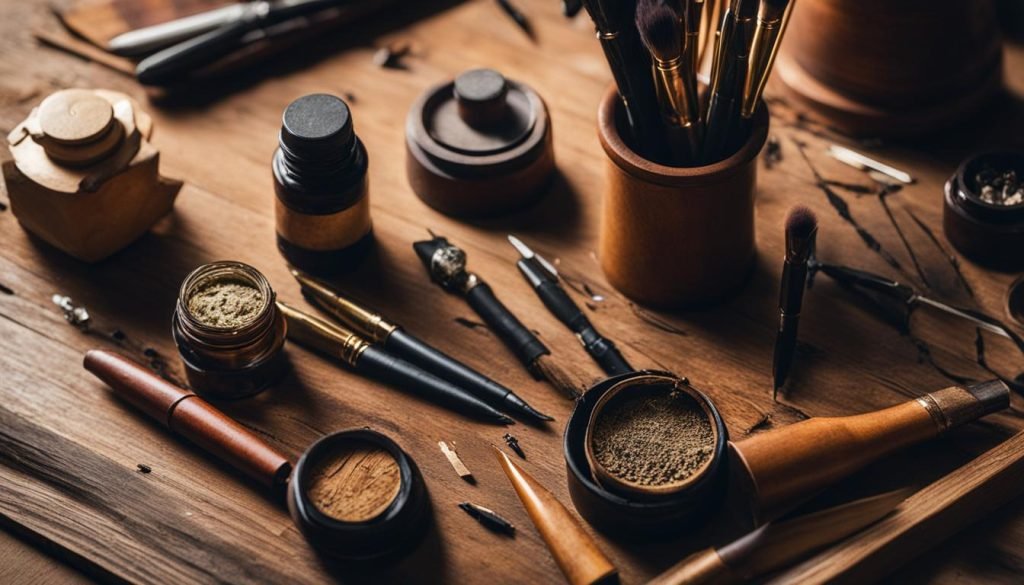
When it comes to calligraphy, selecting the right tools is crucial for achieving the desired results. Whether you’re a beginner or an experienced calligrapher, having the right calligraphy pens and brush pens can make all the difference in your writing. Here, we will guide you on how to choose the perfect tools for your calligraphy journey.
Calligraphy Pens
Calligraphy pens come in various types, each offering unique features and effects. The two most common types are dip pens and fountain pens. Dip pens require a separate nib, which is dipped into ink, allowing for more control and customization in your strokes. Fountain pens, on the other hand, have an internal reservoir that holds the ink, providing a smoother writing experience. When choosing a calligraphy pen, consider factors like nib size, material, and flexibility to find the one that suits your style and comfort.
Brush Pens
Brush pens are a versatile tool for calligraphy, especially for creating bold and expressive lettering. They consist of a brush-like tip that mimics the effects of a traditional brush and ink. Brush pens are available in different sizes and stiffness levels, allowing for variation in stroke widths. They are perfect for both beginners and experienced calligraphers looking to add flair and dynamism to their writing. Experiment with different brush pens to find the one that best suits your desired style and level of control.
Calligraphy Practice Sheets
Practice sheets are essential for honing your calligraphy skills and improving your technique. These sheets provide guidelines for practicing different strokes, letterforms, and letter combinations. They help develop muscle memory and consistency in your writing. Additionally, practice sheets often include exercises to improve letter spacing, slant, and overall composition. Look for practice sheets that cater to your preferred calligraphy style, whether it’s traditional, modern, or a specific script. Regular practice using these sheets will significantly enhance your calligraphy skills over time.
Remember, choosing the right calligraphy tools is a personal preference, so don’t be afraid to explore different options and experiment with various pens and brush pens. Additionally, dedicated practice using practice sheets will help you develop muscle memory and improve your overall calligraphy technique. With the right tools and regular practice, you’ll be well on your way to creating beautiful, artistic lettering.
The Difference between Modern Calligraphy and Hand Lettering
If you’re new to the world of calligraphy, you may have come across two terms that are often used interchangeably: modern calligraphy and hand lettering. While they share similarities, there are distinct differences between the two styles.
Modern calligraphy is a contemporary take on traditional calligraphy. It embraces the foundational principles of calligraphy but allows for more freedom and personal expression. Modern calligraphy often incorporates elements of various lettering styles, creating a unique and artistic approach to letterforms.
Hand lettering, on the other hand, refers to the art of drawing letters by hand. It encompasses a wide range of styles, including but not limited to calligraphy. Hand lettering allows for more flexibility in design and can incorporate embellishments, illustrations, and other graphic elements to enhance the overall composition.
While modern calligraphy focuses on the beauty of letterforms and the rhythm of strokes, hand lettering expands beyond the realm of traditional writing and explores the integration of typography and illustration. Both styles offer endless possibilities for creativity and self-expression, making them popular choices among artists, designers, and those seeking to add a personal touch to their projects.
Examples of Modern Calligraphy and Hand Lettering
To further illustrate the distinction between modern calligraphy and hand lettering, here are some examples:
“The art of modern calligraphy celebrates the elegance of letterforms through fluid and deliberate strokes. It combines the precision of traditional calligraphy with a contemporary twist.”
“Hand lettering is a form of artistic expression that allows for the creation of unique letterforms through illustrative elements and stylized typography. It invites experimentation and encourages the blending of different artistic mediums.”
| Modern Calligraphy | Hand Lettering |
|---|---|
| Focuses on the beauty of letterforms | Explores integration of typography and illustration |
| Uses traditional calligraphy tools | Allows for various artistic mediums |
| Emphasizes precision and rhythm of strokes | Encourages creativity and experimentation |
By understanding the difference between modern calligraphy and hand lettering, you can choose the style that best suits your creative vision and brings your ideas to life.
Overcoming Common Calligraphy Challenges

Improving your calligraphy skills can be both exciting and challenging. As you strive for consistency in your letterforms and aim to create beautiful pieces of art, you may encounter some common obstacles along the way. In this section, we will address these challenges and provide you with valuable tips and techniques to help you overcome them.
Challenge 1: Achieving Consistency in Letterforms
Consistency is key in calligraphy, and it can be a struggle to maintain uniformity in your strokes and letter shapes. To overcome this challenge, practice regularly and focus on mastering the basic calligraphy strokes. Pay attention to the angle and pressure of your pen or brush and strive for evenness in each stroke. Using guidelines or grids can also be helpful in achieving consistent letterforms.
Challenge 2: Improving Overall Skill and Technique
Calligraphy is a skill that requires constant improvement and refinement. To enhance your calligraphy technique, dedicate time to deliberate practice. Focus on specific aspects of your strokes and letterforms that need improvement and work on them systematically. Study the work of experienced calligraphers for inspiration and guidance, and don’t be afraid to experiment with different styles and techniques to find your unique voice.
Challenge 3: Finding Inspiration and Creativity in Calligraphy
Calligraphy is not just about mastering the technical aspects; it’s also about expressing your creativity and connecting with your artistic side. If you find yourself lacking inspiration, try exploring different calligraphy styles and experimenting with various tools and materials. Look for inspiration outside of calligraphy as well, such as nature, art, or literature. Remember that calligraphy is a journey, and finding your own creative path may take time and exploration.
In conclusion, overcoming common calligraphy challenges is part of the learning process and an opportunity for growth. Embrace the journey, be patient with yourself, and continue to practice and improve. With dedication and perseverance, you will develop your calligraphy skills and create beautiful, expressive pieces of art.
History of Basic Calligraphy Strokes

In this section, we will explore the fascinating history and evolution of basic calligraphy strokes. Understanding the origins of these strokes will provide valuable insights into the art form and enhance your appreciation for the techniques used in calligraphy today.
Calligraphy has a rich history that dates back centuries. It has been practiced in various forms and styles across different cultures, each contributing to the development and refinement of calligraphy strokes. From the elegant brushstrokes of Chinese calligraphy to the precise penmanship of Western calligraphy, the evolution of these strokes showcases the creativity and skill of calligraphers throughout history.
Throughout the ages, calligraphy strokes have been influenced by cultural, social, and artistic movements. Different regions and time periods have contributed their unique styles and techniques, resulting in a diverse range of calligraphy strokes. Additionally, the terminology used to describe these strokes has evolved over time, reflecting the changing understanding and appreciation of calligraphy as an art form.
The Evolution of Calligraphy Strokes
To better understand the history of calligraphy strokes, it’s important to examine the key milestones and influences that have shaped their evolution. Here are some notable examples:
| Time Period | Region | Influence |
|---|---|---|
| Ancient China | China | The development of brush calligraphy and the use of distinct brushstrokes for different characters. |
| Islamic Golden Age | Middle East | Arabic calligraphy, characterized by fluid and intricate strokes, became highly regarded for its aesthetic and religious significance. |
| Medieval Europe | Europe | The Gothic script, with its elaborate and ornamental strokes, gained popularity in manuscripts and religious texts. |
| Japanese Edo Period | Japan | Japanese calligraphy, known as shodo, adopted its distinctive strokes and techniques influenced by Chinese calligraphy. |
By exploring the history of calligraphy strokes and the cultural contexts in which they emerged, we can gain a deeper understanding of the art form and find inspiration in the techniques of calligraphers of the past.
“Calligraphy strokes have a rich and varied history, with each stroke holding cultural significance and artistic expression. By studying the evolution of calligraphy strokes, we can engage with the traditions of ancient civilizations and appreciate the timeless beauty of this art form.” – Calligraphy Master
Practicing Calligraphy with Pencil and Paper
If you’re a beginner looking to explore the art of calligraphy, practicing with pencil and paper can be a great way to start. This method offers accessibility and affordability, allowing you to hone your skills without investing in specialized tools. In this section, we will guide you through the process of practicing calligraphy with pencil and paper, providing tips and techniques to help you get started.
Basic Calligraphy Supplies
Before we dive into the practice techniques, let’s take a look at the basic calligraphy supplies you’ll need:
- A pencil with a smooth lead – preferably an HB or 2B pencil
- A calligraphy guideline sheet or a ruler to create your own guidelines
- A smooth and high-quality paper, such as Bristol board or calligraphy practice paper
- An eraser to correct any mistakes or smudges
The Right Pencil Grip
The correct pencil grip is crucial for achieving control and precision in your calligraphy strokes. Here are some tips to help you establish a proper grip:
- Hold the pencil lightly between your thumb, index, and middle fingers.
- Angle the pencil at a comfortable slant, allowing for smooth movement.
- Keep your wrist loose and relaxed to avoid tension.
- Practice writing short strokes and gradually build up to longer strokes.
By practicing calligraphy with pencil and paper, you can develop a solid foundation for your letterforms and gain a better understanding of stroke consistency and control. Remember to be patient with yourself and practice regularly to improve your skills. With dedication and practice, you’ll soon be creating beautiful calligraphy pieces using a variety of tools.
Brush Pen Calligraphy for Beginners
If you’re looking to dive into the world of calligraphy but prefer a more versatile and beginner-friendly tool, brush pens are an excellent choice. These pens combine the ease of use of a marker with the ability to create beautiful brush-like strokes. Whether you’re a complete beginner or have some experience with calligraphy, brush pens offer endless possibilities for creativity.
When it comes to brush pen calligraphy, choosing the right pen is crucial. There are various types of brush pens available, each with its own unique characteristics. Some pens have a flexible brush tip that allows you to create both thick and thin strokes effortlessly, while others have a firmer tip that provides more control. Experiment with different pens to find the one that suits your style and preferences.
Once you have your brush pen, it’s time to explore different techniques to create gorgeous letterforms. Brush pen calligraphy offers the opportunity to experiment with variations in pressure, angle, and speed to achieve different effects. Practice creating thick downstrokes and delicate upstrokes, and experiment with letter spacing to add your personal touch to your calligraphy.
Remember, practice is key when it comes to brush pen calligraphy. Set aside regular time to practice various letterforms, words, and phrases. You can find printable practice sheets online or create your own. As you gain confidence and proficiency, you’ll be able to explore more advanced techniques and develop your unique style in brush pen calligraphy.
The Art of Pressure Control in Calligraphy
In the world of calligraphy, mastering the art of pressure control is crucial for achieving beautiful and balanced letterforms. Understanding how to apply the right amount of pressure to your pen or brush is what creates those elegant thick and thin strokes that bring your calligraphy to life. Whether you’re using a traditional dip pen or a modern brush pen, honing your pressure control skills will take your calligraphy to the next level.
One technique for practicing pressure control is to start with basic strokes. Begin by applying gentle pressure on the downstrokes to create thicker lines, and release pressure on the upstrokes to create thinner lines. This contrast between thick and thin lines adds depth and dimension to your letterforms. Remember to maintain a consistent angle and speed to achieve uniformity in your strokes.
“In calligraphy, the pressure you apply to your pen is what gives character and personality to your letterforms. It’s what makes your calligraphy unique and captivating.”
Another exercise for refining your pressure control is to experiment with different writing surfaces. Try practicing on smooth paper, textured paper, or even unconventional surfaces like fabric or wood. Each surface will respond differently to the pressure of your pen, allowing you to develop a more versatile and adaptable technique.
| Benefits of Pressure Control in Calligraphy | Techniques for Practicing Pressure Control |
|---|---|
| 1. Creates contrast and visual interest in your letterforms | 1. Start with basic strokes and focus on applying varying pressure |
| 2. Adds depth and dimension to your calligraphy | 2. Experiment with different writing surfaces to understand how pressure affects your strokes |
| 3. Enhances the overall appearance and elegance of your calligraphy | 3. Practice with different tools and nib sizes to explore the impact of pressure on different instruments |
Remember, mastering pressure control in calligraphy takes time and practice. Be patient with yourself and enjoy the process of discovering your own unique style. With dedication and perseverance, you’ll soon be creating stunning calligraphy pieces that showcase the beauty of thick and thin strokes.
Next: Expanding Your Calligraphy Journey
Expanding Your Calligraphy Journey
Now that you have mastered the basics of calligraphy, it’s time to take your skills to the next level. By exploring advanced calligraphy techniques, utilizing calligraphy resources, and enrolling in calligraphy courses, you can continue to grow as a calligrapher and expand your creative horizons.
One way to enhance your calligraphy skills is by delving into advanced techniques. Experiment with different styles, such as flourishing, where you embellish your letters with decorative elements. This can add a touch of elegance and personality to your calligraphy pieces. Explore the art of lettering compositions, where you combine different letterforms into beautiful and cohesive designs. These advanced techniques will challenge you to push the boundaries of your creativity and showcase your unique style.
As you continue your calligraphy journey, it’s essential to leverage available calligraphy resources. Online communities and forums dedicated to calligraphy provide valuable insights, tips, and inspiration from fellow calligraphers. Engage with these communities, share your work, and seek feedback to further refine your skills. Additionally, explore books, magazines, and online tutorials that offer in-depth guidance on advanced calligraphy techniques, letterforms, and project ideas. By immersing yourself in these resources, you’ll continue to learn and discover new approaches to calligraphy.
| Advanced Calligraphy Techniques | Calligraphy Resources | Calligraphy Courses |
|---|---|---|
| – Flourishing | – Online communities and forums | – Local calligraphy workshops |
| – Lettering compositions | – Books, magazines, and online tutorials | – Online calligraphy courses |
| – Creative layouts and designs | – Calligraphy supply stores | – Calligraphy retreats and conferences |
Remember, practice is key. Dedicate regular time to hone your skills and experiment with new techniques. The more you practice, the more you’ll refine your craft and develop your unique calligraphic style.
Lastly, consider enrolling in calligraphy courses to receive expert guidance and structured learning. Many experienced calligraphers offer online courses that cater to different skill levels and areas of interest. These courses provide a structured learning environment, comprehensive resources, and personalized feedback to help you progress in your calligraphy journey. Whether you prefer live virtual classes or self-paced modules, there are options available to suit your learning style and schedule.
By expanding your calligraphy journey through advanced techniques, utilizing calligraphy resources, and enrolling in calligraphy courses, you’ll continue to evolve as a calligrapher and unleash your creative potential. Embrace the opportunities that lie ahead and continue to explore the beautiful art of calligraphy.
Conclusion
Congratulations on taking the first step towards your calligraphy journey! This guide has provided you with the essential knowledge and techniques to get started with calligraphy. By understanding and practicing the basic calligraphy strokes, you are on your way to mastering this beautiful art form.
Remember, calligraphy is a skill that requires patience and dedication. Consistent practice is key to improving your letterforms and developing your own unique style. Don’t be afraid to experiment and explore different calligraphy styles to find what resonates with you.
As you continue your calligraphy journey, there are plenty of resources available to support your growth. Online courses, books, and communities of fellow calligraphers can provide additional guidance and inspiration. Keep exploring, learning, and pushing your boundaries to unlock your full calligraphy potential.
So, grab your pen, brush, or pencil, and let your creativity flow. Remember, the key to becoming proficient in calligraphy is practice and perseverance. Embrace the joy of creating beautiful letterforms and enjoy the art of calligraphy!
FAQ
What are calligraphy guidelines and why are they important?
Calligraphy guidelines are the basic strokes and forms that serve as a foundation for creating beautiful letterforms. They are essential for achieving line perfection in calligraphy by providing a framework for consistent and cohesive lettering.
What are basic calligraphy strokes?
Basic calligraphy strokes are the individual strokes that make up lowercase letters in calligraphy. These strokes form the building blocks of calligraphy and are essential for creating cohesive and consistent letterforms.
How should I practice calligraphy?
It is important to practice calligraphy by understanding and practicing each stroke individually. This will help you achieve consistency and improve your overall skill and technique. It is also recommended to use the right tools and materials and practice with useful practice sheets.
What tools do I need for calligraphy?
There are different types of calligraphy pens and brush pens that you can use. It is important to have the correct grip and posture when using these tools. Practice sheets can also be useful for honing your calligraphy skills.
What is the difference between modern calligraphy and hand lettering?
Modern calligraphy is based on traditional principles but allows for more freedom and personal expression. Hand lettering, on the other hand, is a broader term that encompasses various styles of lettering. Both styles can be used in different settings.
What are some common challenges faced by beginners in calligraphy?
Beginners in calligraphy often struggle with achieving consistency in letterforms and improving their overall skill and technique. Finding inspiration and creativity in calligraphy can also be challenging. However, with practice and perseverance, these challenges can be overcome.
How has calligraphy evolved over time?
Calligraphy strokes have evolved over time due to the influence of different cultures and time periods. Terminology for these strokes has also evolved. Understanding the history of basic calligraphy strokes can provide insights into the development of this art form.
Can I practice calligraphy with a pencil and paper?
Yes, practicing calligraphy with a pencil and paper is a more accessible and affordable method for beginners. By learning the correct pencil grip and using specific types of pencils, you can practice and improve your calligraphy skills.
How can I use brush pens for calligraphy?
Brush pens are a popular tool for calligraphy. There are different types of brush pens available, each with its own characteristics. By learning various brush pen techniques, you can achieve thick and thin strokes, adding depth and variation to your calligraphy.
What is the importance of pressure control in calligraphy?
Pressure control is crucial in achieving thick and thin strokes in calligraphy. It adds visual interest and enhances the overall appearance of your lettering. Practicing pressure control exercises and techniques can help you master this skill.
How can I expand my calligraphy skills beyond the basics?
There are various opportunities for further growth and development in calligraphy. You can explore advanced techniques, seek out resources for learning and inspiration, and even consider enrolling in calligraphy courses to enhance your skills and expand your knowledge.

